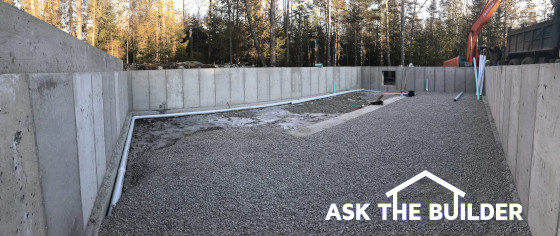Capturing Radon Secrets Revealed

Radon gas is going to pass through the coarse open gravel, go into the white pipe and be transported to the roof via the green vertical pipe on the far foundation wall. This column was SO GOOD that I shared with the 31,000 subscribers who read my December 11, 2018 AsktheBuilder Newsletter. (C) Copyright 2018 Tim Carter
Capturing Radon Secrets
DEAR TIM: I’m building a new home and someone at a Christmas party asked me what my builder was going to do about radon. I’ve never heard of radon and thought it was a joke. Is radon an issue and what can be done about it in new construction? The foundation is going to be poured in a few weeks and I’m hoping it’s not too late to do something. Leslie M., Mt. Desert Island, Maine
Have you ever been at a Christmas party, or some other gathering like it, when you go home more upset than when you came? It can happen when you share new home construction news! Everyone seems to have an opinion and you may get both good and bad advice from people who think they know a good deal about any given topic.
What is Radon?
In this case, Leslie got some good advice. Radon is a colorless odorless gas that can cause health issues. This gas is generated by the decomposition of uranium, a natural element. Some types of bedrock contain more uranium than others. The radon gas works its way out of the rock, up into the soil, and into groundwater. It’s constantly clawing its way to the atmosphere.
There’s some debate as to the amount of exposure that’s required to cause health issues, but I’ll leave that up to the medical experts to hash over. The good news is that it’s very, very inexpensive and easy to ensure radon doesn’t cause you any problems if you’re building a new home. In most cases, it takes just three hours or less and some simple pipe to eliminate worry.
How wide spread is the radon risk?
I went online and looked at several maps that indicate radon risk potential for the contiguous 48 states here in the USA. Just doing a simple estimation, it appears to me that just about sixty-five percent of the lower 48 US states have a moderate or high potential for radon infiltration.
You can talk with different radon experts and my guess is you’ll get multiple methods to capture and redirect the radon that’s underneath your home. Here’s how I’ve always dealt with this small challenge.
Most new homes that have full basements, or crawlspaces, have a poured concrete slab in the basement. It’s a good idea to put in a slab in a crawlspace too. These slabs, in almost all cases, are poured over some type of washed gravel. The gravel can be from 8 to 10 inches thick and often can range in size from green peas to grapes or walnuts. Water and gas travel fast through this type of material.
It’s important to realize this gravel shouldn’t have any sand in it. Sand slows down the movement of water and gas to an extent. The thick gravel allows a low-paid worker to install a perimeter pipe on the inside of the footing with minimal effort. For sake of discussion, let’s say the gravel is 8 inches thick and you’re going to install common 4-inch perforated drain tile pipe.
You’d put in about 2 inches of gravel over the soil, then you’d put in the perforated pipe. I prefer to use solid straight pipe that has two rows of 1/2-inch diameter holes drilled into it about every 6 to 8 inches. I always place the holes aiming down, not up.
You can install extra pipe that crosses over the center of the basement floor much like a large sheet of graph paper, but I don’t feel it’s necessary. The pipe around the entire inner perimeter of the foundation is sufficient to capture the radon gas because it can work its way through the open gravel.
At one spot in the horizontal pipe, you need to install a tee fitting aiming to the sky. A solid 4-inch pipe is glued into the tee. Once the house is constructed, this solid pipe, with no holes in it, will continue up through the house and out the roof. This pipe acts like a chimney and radon floats out of it. Anytime the wind blows over the top of the pipe, it creates a vacuum and radon is actively pulled out of the soil under your home.
Once the rest of the gravel is installed to cover the pipes and before the concrete slab is poured, it’s mission critical to install a giant sheet of cross-laminated vapor retarder over the gravel. This plastic should meet the ASTM E1745 standard. Do NOT skip this step. If you can’t get one giant sheet and there have to be seams, be sure you get the approved tape made by the plastic vapor retarder company and tape all the overlap seams of the plastic.
Be sure the plastic extends to the side walls of the foundation. This vapor retarder prevents radon from getting into your home through shrinkage cracks that will open up in your slab within a month or two after it’s poured. A year after the slab is poured you’ll notice a small gap between the slab and the foundation wall and in other locations. These gaps need to be filled with a very high-quality caulk.
Column 1278
2 Responses to Capturing Radon Secrets Revealed